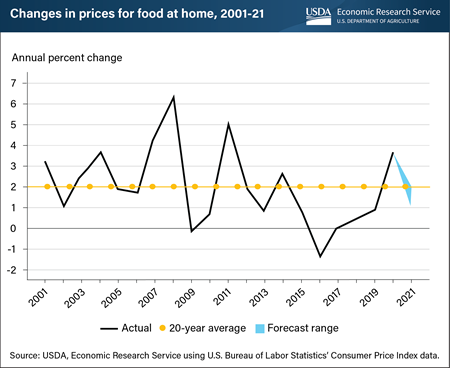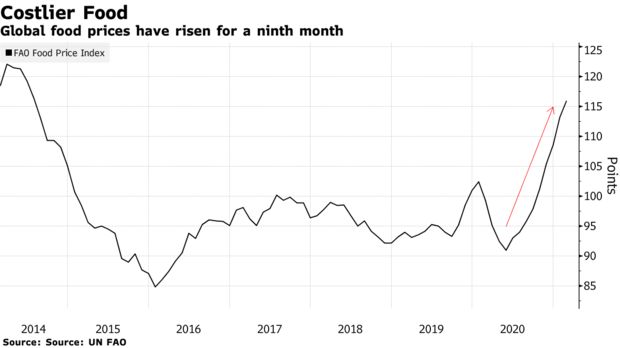
But this isn’t exactly a new phenomenon. Grocery prices, and especially eating-out prices, have a history of being volatile — even before the pandemic. However, Covid-19 brings a whole new list of challenges to the food industry that we haven’t seen in recent years.
When our physiological needs change, even the most static daily routine must shift and adapt. Food is the foundation of our human needs… In short, volatility in the food industry is a challenge.
But volatility is especially challenging in our current economic and environmental climate.
There’s a prodigious amount of info on the web that details how Covid-19 struck the food industry. The purpose of this piece is not to recount every CPI change within the food industry microcosm detailed by the Bureau of Labor Statistics (BLS).
We’re simply looking at modern events from a macro-perspective.
So let’s zoom out and get a bird’s eye view of what’s actually happening right now in the food and CPG industry. We are going to examine the shift in food prices and how to navigate the road ahead.
“The COVID-19 pandemic, along with the associated lockdowns, mobility restrictions and physical distancing rules, has not only led to a significant increase in unemployment and considerable income losses for many people, but has also altered the spending patterns of consumers and the level of price inflation that they face. In particular, the lockdown measures have affected the supply of and demand for certain products and, hence, their prices.”
International Labour Organization [1]
Many categories of consumer spending have been impacted by the Covid-19 pandemic. The grocery category was amongst the hardest hit [2].
We are looking at a 3.9% CPI increase from December 2019 - 2020 (largest over-the-year increase since 2011), and a 3.5% increase from February 2020 - 2021 [3].
[Definition of Consumer Price Index (CPI) - measure of the average change over time in the prices paid by urban consumers for a market basket of consumer goods and services]
And the reasons for this increase can be a bit tricky. It’s important to note that… well, everything impacts everything.
Aspects of the pandemic shut down restaurants, which increased grocery store purchases, which increased demand, which increased the need for transportation and storage and sanitation and upkeep of agricultural products, which increased labor costs…
You get the picture. The list goes on and on and on.
To put this mess into perspective, the U.S. Department of Agriculture Economic Research Service illustrates where your money goes when you spend it on food [4].

Looking at the food dollar, it’s a bit easier to picture the rumpled state Covid-19 left us in.
The BLS details pandemic price changes further by explaining that “demand shocks and problems with supply chains contributed to increased volatility in import, export, producer, and consumer prices in the months following the onset of the COVID-19 pandemic in the United States.” [5].
What Does the Food Price Volatility Caused by Covid-19 Mean?
This pandemic changed the way we’ll view the world going forward. There’s no doubt about that.
These facets (and many more not listed) of the food industry are going through an axiomatic shift. But what this means exactly for the world at large remains to be seen.
Experts have varying opinions on this.
The U.S. Department of Agriculture states their findings saying “food prices increased more rapidly than average in 2020…”. But researchers at the USDA, Economic Research Service (ERS) “expect food price inflation to retreat over the course of 2021 and converge closer to the 20-year historical average.“ [6]

Shirley Mustafa, an economist at the UN’s Rome-based Food and Agriculture Organization, talks about pressure upon economic hardship for the vulnerable. She stated that “higher international prices could really go to exacerbate the economic hardship caused by the pandemic, especially for some vulnerable groups.” [7].

Similar to Mustafa’s sentiment, the International Labour Organization had this to say about the vulnerable: “Increases in food prices can have a major impact on the living standards of lower‑income households, which generally spend most of their income on food. Even a small increase can confront the members of such households with difficult decisions” [8].
Lastly, Isaac Olvera, lead economist at ArrowStream says that “reopening restaurants will be inflationary, as wholesale food supplies will be reallocated between retail and food service, though it’s unknown how actively consumers will return to restaurants in a post-pandemic world” [9].
Here are some fun predictions and thoughts concerning sustainability moving forward. Due to an admixture of market volatility and consumer demand, the world is changing.
Less Meat?
Bloomberg did a little piece on findings from researchers at the University of Missouri’s Food & Agricultural Policy Research Institute predicting that this year’s per-capita meat consumption will fall for the first time since 2014.
Bloomberg writes that “per-capita meat consumption won’t return to last year’s levels until at least after 2025” [10].
Plants are taking over. Which isn’t a bad thing.
Plant-Based Meat is On the Menu
As we noted above, Covid-19 really did a number on much of the food industry’s supply chain.
But not all folks were affected the same.
The Good Food Institute notes that “by removing animals from the production equation, plant-based meat companies are not beholden to the systemic shocks affecting the animal-based meat supply chain” [11].
They go on to explain Impossible Burger’s explosion in groceries during the pandemic and how more direct-to-consumer offerings are becoming available to people shopping online.
We’d love to hear from you!
If you have any questions or thoughts, throw them in the comments below.
